| Before the J. League | |
 Like
most other J. League clubs, Urawa Reds started out as a company-based team run
for the benefit of company staff. It all began in 1950 with the formation of a
football club at Kobe-based Shin-Mitsubishi Heavy Industries. The club relocated
to Tokyo together with the company in 1958. The company changed its name to Mitsubishi
Heavy Industries in 1964. Before long, they had developed to become one of the
powerhouses of Japanese company football, a status that was maintained for the
next three decades. When Japan's first non-professional national league, the Japan
Soccer League (JSL), was launched in 1965, Mitsubishi were one of the eight founding
members. Four Mitsubishi players were regular members of the team that won Japan's
historic bronze medal at the Mexico Olympics of 1968, including goalkeeper Kenzo
Yokoyama and midfielder Takaji Mori. That success gave a great spur to football's
popularity in Japan, a change symbolised by a match between Mitsubishi and Yanmar
at the National Stadium in Tokyo on November 17, 1968, that featured several Olympic
stars and attracted a record JSL crowd of 40,000. Mitsubishi's greatest period
was from 1969 to 1982, when they won the league championship 4 times, came second
6 times, and also took the Emperor's Cup on 4 occasions. In 1978, Mitsubishi won
Japan's first ever treble (the league, Emperor's Cup and League Cup). For the
League Cup, the first of those three trophies, the team colour was changed from
blue to red, and it has stayed that way ever since. The 1980's included a difficult
patch and the team were even relegated to Division 2 at the end of the 1988/89
season. A young striker named Masahiro Fukuda arrived at the club the following
year and they bounced straight back by winning Division 2. The club changed umbrellas
from Mitsubishi Heavy Industries to Mitsubishi Motors for the 1990/91 season in
preparation for joining the J. League -- the nation's first professional football
league -- again as founding members. Like
most other J. League clubs, Urawa Reds started out as a company-based team run
for the benefit of company staff. It all began in 1950 with the formation of a
football club at Kobe-based Shin-Mitsubishi Heavy Industries. The club relocated
to Tokyo together with the company in 1958. The company changed its name to Mitsubishi
Heavy Industries in 1964. Before long, they had developed to become one of the
powerhouses of Japanese company football, a status that was maintained for the
next three decades. When Japan's first non-professional national league, the Japan
Soccer League (JSL), was launched in 1965, Mitsubishi were one of the eight founding
members. Four Mitsubishi players were regular members of the team that won Japan's
historic bronze medal at the Mexico Olympics of 1968, including goalkeeper Kenzo
Yokoyama and midfielder Takaji Mori. That success gave a great spur to football's
popularity in Japan, a change symbolised by a match between Mitsubishi and Yanmar
at the National Stadium in Tokyo on November 17, 1968, that featured several Olympic
stars and attracted a record JSL crowd of 40,000. Mitsubishi's greatest period
was from 1969 to 1982, when they won the league championship 4 times, came second
6 times, and also took the Emperor's Cup on 4 occasions. In 1978, Mitsubishi won
Japan's first ever treble (the league, Emperor's Cup and League Cup). For the
League Cup, the first of those three trophies, the team colour was changed from
blue to red, and it has stayed that way ever since. The 1980's included a difficult
patch and the team were even relegated to Division 2 at the end of the 1988/89
season. A young striker named Masahiro Fukuda arrived at the club the following
year and they bounced straight back by winning Division 2. The club changed umbrellas
from Mitsubishi Heavy Industries to Mitsubishi Motors for the 1990/91 season in
preparation for joining the J. League -- the nation's first professional football
league -- again as founding members. |
| 1992 #Birth of Urawa Reds | |
 The
name was changed from Mitsubishi to Urawa Red Diamonds and the first Reds team
played in the inaugural J. League Yamazaki Nabisco Cup -- in effect, the pre-J.
League tournament -- in 1992. They were guided by former Mitsubishi player Takaji
Mori, who had since also managed the Japan national team. The team featured two
players from Argentina, Osvaldo Escudero and Marcelo Trivisonno, and a Japanese-Peruvian,
Edwin Uehara. Reds finished fifth in the first-round group stage and did not advance
to the semi-finals. They did, however, reach the Emperor's Cup semi-finals, and
approached the J. League's opening season with high expectations. The
name was changed from Mitsubishi to Urawa Red Diamonds and the first Reds team
played in the inaugural J. League Yamazaki Nabisco Cup -- in effect, the pre-J.
League tournament -- in 1992. They were guided by former Mitsubishi player Takaji
Mori, who had since also managed the Japan national team. The team featured two
players from Argentina, Osvaldo Escudero and Marcelo Trivisonno, and a Japanese-Peruvian,
Edwin Uehara. Reds finished fifth in the first-round group stage and did not advance
to the semi-finals. They did, however, reach the Emperor's Cup semi-finals, and
approached the J. League's opening season with high expectations.Yamazaki Nabisco Cup : 5th in the Group Emperor's Cup : Semi-finals |
| 1993 #Hesitant Beginnings | |
 Reds
struggled in their first J. League season. Pre-season problems at the preparatory
level were compounded by the early departure of two Argentine signings, Victor
Ferreyra and Marcelo Morales. The club brought in Germans Michael Rummenigge and
Uwe Rahn, and Slovak keeper Miroslav Mentel in mid-season, but with injuries,
too, finished last in both the First and Second Stages. On the bright side, Reds
drew sell-out crowds at every home game. Takaji Mori stepped down as manager at
the end of the season. Reds
struggled in their first J. League season. Pre-season problems at the preparatory
level were compounded by the early departure of two Argentine signings, Victor
Ferreyra and Marcelo Morales. The club brought in Germans Michael Rummenigge and
Uwe Rahn, and Slovak keeper Miroslav Mentel in mid-season, but with injuries,
too, finished last in both the First and Second Stages. On the bright side, Reds
drew sell-out crowds at every home game. Takaji Mori stepped down as manager at
the end of the season.Yamazaki Nabisco Cup : 5th in the Group Emperor's Cup : Semi-finals |
| 1994 #Buchwald Arrives! | |
 Guido
Buchwald and Uwe Bein joined Reds in July to give the team more stability in defence
and new attacking options. Reds, now under Kenzo Yokoyama, were looking better
and new winger Masayuki Okano was entertaining the fans with extraordinary displays
of speed. But the results still were not coming and Reds wound up bottom again
in the First Stage for the third stage in a row. Bein was injured for the Second
Stage, but this time Reds climbed up one place from the bottom. Guido
Buchwald and Uwe Bein joined Reds in July to give the team more stability in defence
and new attacking options. Reds, now under Kenzo Yokoyama, were looking better
and new winger Masayuki Okano was entertaining the fans with extraordinary displays
of speed. But the results still were not coming and Reds wound up bottom again
in the First Stage for the third stage in a row. Bein was injured for the Second
Stage, but this time Reds climbed up one place from the bottom.J. League Suntory Series : 12th/12 J. League Nicos Series : 11th/12 Overall : 12th/1 Yamazaki Nabisco Cup : Second round Emperor's Cup : Quarter-finals |
| 1995 #Reds Rising | |
 New
German manager Holger Osieck discovered superior balance with Buchwald at the
back, Bein in midfield and strikers Fukuda and Okano leading the attack. Reds
even had a chance to win the First Stage but eventually ended third behind Yokohama
Marinos and Verdy Kawasaki. Fukuda, with 32 goals, became the young league's first
Japanese top scorer and Reds finished a highly creditable fourth in the overall
standings. Komaba Stadium was renovated to hold 21,500. New
German manager Holger Osieck discovered superior balance with Buchwald at the
back, Bein in midfield and strikers Fukuda and Okano leading the attack. Reds
even had a chance to win the First Stage but eventually ended third behind Yokohama
Marinos and Verdy Kawasaki. Fukuda, with 32 goals, became the young league's first
Japanese top scorer and Reds finished a highly creditable fourth in the overall
standings. Komaba Stadium was renovated to hold 21,500.J. League Suntory Series : 3rd/14 J. League Nicos Series : 8th/14 Overall : 4th/14 Yamazaki Nabisco Cup : not held Emperor's Cup : Quarter-finals |
| 1996 #Aiming for the Title | |
 France
defender Basile Boli teamed up with Buchwald to add further security at the back.
Okano and new forward Kenji Oshiba kept opponents on their toes despite the frequent
absence of Fukuda through injury. 1996 was the year when the J. League was played
without stages as a single, season-long tournament, and Reds' consistency took
them close to the title. Only a penalty shoot-out separated Reds and the champions,
Kashima Antlers, in the decisive match on November 2. Osieck and Bein left at
the end of the season. France
defender Basile Boli teamed up with Buchwald to add further security at the back.
Okano and new forward Kenji Oshiba kept opponents on their toes despite the frequent
absence of Fukuda through injury. 1996 was the year when the J. League was played
without stages as a single, season-long tournament, and Reds' consistency took
them close to the title. Only a penalty shoot-out separated Reds and the champions,
Kashima Antlers, in the decisive match on November 2. Osieck and Bein left at
the end of the season.J. League : 6th/16 Yamazaki Nabisco Cup : Qualifying league Emperor's Cup : Semi-finals |
| 1997 #Times of Trial and Error | |
 Reds'
new passing game under Horst Koppel never quite gelled and the German manager
stayed only one season. New Austrian signing Michael Baur had difficulty adjusting
to life in Japan and left soon after the start. The new signings for the Second
Stage were Spain midfielder Aitor Beguiristain and Dutch defender Alfred Nijhuis.
Yugoslavia international Zeljko Petrovic also arrived in time for the Emperor's
Cup but the overall consistency had slipped away and Buchwald, too, left after
the finish. Reds'
new passing game under Horst Koppel never quite gelled and the German manager
stayed only one season. New Austrian signing Michael Baur had difficulty adjusting
to life in Japan and left soon after the start. The new signings for the Second
Stage were Spain midfielder Aitor Beguiristain and Dutch defender Alfred Nijhuis.
Yugoslavia international Zeljko Petrovic also arrived in time for the Emperor's
Cup but the overall consistency had slipped away and Buchwald, too, left after
the finish.J. League First Stage : 9th/17 J. League Second Stage : 7th/17 Overall : 10th/17 Yamazaki Nabisco Cup : Second round Emperor's Cup : Fourth round |
| 1998 #New Star: Shinji Ono | |
 An
18-year-old midfielder, Shinji Ono, became the pride of Reds and then all Japan
when called up by manager Takeshi Okada to join the squad for Japan's first ever
World Cup at France '98. Reds, under new coach Hiromi Hara, had their nose in
front in the second stage but the form fell while Ono was away at the Asian Youth
Championship. Reds finished third, but Ono was named the J. League's best new
player of the year and voted onto the league's Best XI. He was also the AFC's
Asian Player of the year. An
18-year-old midfielder, Shinji Ono, became the pride of Reds and then all Japan
when called up by manager Takeshi Okada to join the squad for Japan's first ever
World Cup at France '98. Reds, under new coach Hiromi Hara, had their nose in
front in the second stage but the form fell while Ono was away at the Asian Youth
Championship. Reds finished third, but Ono was named the J. League's best new
player of the year and voted onto the league's Best XI. He was also the AFC's
Asian Player of the year.J.League First Stage : 7th/18 J.League Second Stage : 3rd/18 Overall : 6th/18 Yamazaki Nabisco Cup : Qualifying league Emperor's Cup : Quarter-finals |
| 1999 #Relegation | |
 The
J. League introduced a two-division format in 1999, and Reds were one of the first
two clubs to go down. Ono was absent, first on FIFA U-20 World Youth Championship
duty and then due to a serious knee injury suffered in June. Hara was dismissed
after Reds finished 13th out of 16 in the first stage, but his replacement, Dutchman
Aad de Mos, could not turn the tide. Reds eventually went down on goal difference.
Even an extra time winner by Fukuda in the final match was not quite enough. The
J. League introduced a two-division format in 1999, and Reds were one of the first
two clubs to go down. Ono was absent, first on FIFA U-20 World Youth Championship
duty and then due to a serious knee injury suffered in June. Hara was dismissed
after Reds finished 13th out of 16 in the first stage, but his replacement, Dutchman
Aad de Mos, could not turn the tide. Reds eventually went down on goal difference.
Even an extra time winner by Fukuda in the final match was not quite enough.J. League First Stage : 13th/16 J. League Second Stage : 14th/16 Overall : 15th/16 Yamazaki Nabisco Cup : Qualifying league Emperor's Cup : Fourth round |
| 2000 #Straight back | |
 Kazuo
Saito took charge with the brief to lift the club back into the top flight in
only one season. Beguiristain had left, but Reds signed Polish forward Andrzej
Kubica. It was a gruelling 44-game season and the final run in a hard uphill struggle.
Saito was assisted from mid-season by former Reds manager Kenzo Yokoyama, now
general manager, and Brazilian physical coach Luis Flavio also joined for the
finishing stretch. Reds clinched promotion with a golden goal in extra time of
the very last match. Kazuo
Saito took charge with the brief to lift the club back into the top flight in
only one season. Beguiristain had left, but Reds signed Polish forward Andrzej
Kubica. It was a gruelling 44-game season and the final run in a hard uphill struggle.
Saito was assisted from mid-season by former Reds manager Kenzo Yokoyama, now
general manager, and Brazilian physical coach Luis Flavio also joined for the
finishing stretch. Reds clinched promotion with a golden goal in extra time of
the very last match.J. League Division 2 : 2nd/11 Yamazaki Nabisco Cup : First round Emperor's Cup : Fourth round |
| 2001 #Farewell to Ono | |
 2001
was Reds' Brazilian year. The new signings included Brazil national team midfielder
Donizete, Adriano and Tuto, plus Masami Ihara, the most capped player in Japanese
football history with 123 international メAモ caps. Ono returned to top condition
and performed wonders in the First Stage, but the team slumped again after he
left for Feyenoord in the summer. Brazilian manager Tita was replaced by compatriot
and assistant, Pita. Reds staved off relegation with the help of two more Brazilians
signed in mid-season, forward Emerson and midfielder Harison. 2001
was Reds' Brazilian year. The new signings included Brazil national team midfielder
Donizete, Adriano and Tuto, plus Masami Ihara, the most capped player in Japanese
football history with 123 international メAモ caps. Ono returned to top condition
and performed wonders in the First Stage, but the team slumped again after he
left for Feyenoord in the summer. Brazilian manager Tita was replaced by compatriot
and assistant, Pita. Reds staved off relegation with the help of two more Brazilians
signed in mid-season, forward Emerson and midfielder Harison.J. League First Stage : 7th/16 J. League Second Stage : 12th/16 Overall : 10th/16 Yamazaki Nabisco Cup : Quarter-finals Emperor's Cup : Semi-finals |
| 2002 #Getting Close | |
 Former
Japan manager Hans Ooft re-laid the foundations to turn Reds into title contenders.
Fukuda was pulled back into midfield to feed the Brazilian attacking duo of Emerson
and Tuto. In October, Reds reached the League Cup final and briefly led the league's
Second Stage. But they bowed to Kashima Antlers in the cup, defeated by an unfortunate
deflection, and went on to lose their last 6 league matches. Defender Keisuke
Tsuboi was named the J. League's best new player. Fukuda and Ihara both retired
at the end of the season. Former
Japan manager Hans Ooft re-laid the foundations to turn Reds into title contenders.
Fukuda was pulled back into midfield to feed the Brazilian attacking duo of Emerson
and Tuto. In October, Reds reached the League Cup final and briefly led the league's
Second Stage. But they bowed to Kashima Antlers in the cup, defeated by an unfortunate
deflection, and went on to lose their last 6 league matches. Defender Keisuke
Tsuboi was named the J. League's best new player. Fukuda and Ihara both retired
at the end of the season.J. League First Stage : 11th/16 J. League Second Stage : 8th/16 Overall : 11th/16 Yamazaki Nabisco Cup : Runners-up Emperor's Cup : Third round |
| 2003 #A Trophy at Last! | |
 Brazil
international Edmundo was briefly on the books at the start of the season. His
sud- den departure unsettled Reds' early league campaign but the rise of young
players such as Koji Yamase and Makoto Hasebe brought new quality to the side.
Australia defender Ned Zelic and Russia defender Yuri Nikiforov came in at the
back, and Emerson discovered a goal-scoring hotline in partnership with Tatsuya
Tanaka. In the League Cup, Reds won their first ever J. League title 4-0 against
Antlers in a rematch of the 2002 final. Ooft left at the end of the season. Brazil
international Edmundo was briefly on the books at the start of the season. His
sud- den departure unsettled Reds' early league campaign but the rise of young
players such as Koji Yamase and Makoto Hasebe brought new quality to the side.
Australia defender Ned Zelic and Russia defender Yuri Nikiforov came in at the
back, and Emerson discovered a goal-scoring hotline in partnership with Tatsuya
Tanaka. In the League Cup, Reds won their first ever J. League title 4-0 against
Antlers in a rematch of the 2002 final. Ooft left at the end of the season.J. League First Stage : 6th/16 J. League Second Stage : 6th/16 Overall : 6th/16 Yamazaki Nabisco Cup : Winners Emperor's Cup : Third round |
| 2004 #Second Stage Champions | |
 Guido
Buchwald took charge and Reds made unprecedented signings for their league championship
campaign: national team players Alex, Masayuki Okano and Tomoyuki Sakai, and Olympic
defender Tulio. Turkey defender Alpay Ozalan and Nene from Brazil also joined
midway. Reds stayed top from game two of the Second Stage, which started in August,
and won the Second Stage title in overwhelming form. The Suntory Championship,
however, ended 1-1 on aggregate and Yokohama F.Marinos took the penalty shootout
4-2. The overall title slipped from Reds' grasp. Guido
Buchwald took charge and Reds made unprecedented signings for their league championship
campaign: national team players Alex, Masayuki Okano and Tomoyuki Sakai, and Olympic
defender Tulio. Turkey defender Alpay Ozalan and Nene from Brazil also joined
midway. Reds stayed top from game two of the Second Stage, which started in August,
and won the Second Stage title in overwhelming form. The Suntory Championship,
however, ended 1-1 on aggregate and Yokohama F.Marinos took the penalty shootout
4-2. The overall title slipped from Reds' grasp.J. League First Stage : 3rd/16 J. League Second Stage : 1st/16 Overall : 2nd/16 Yamazaki Nabisco Cup : Runners Up Emperor's Cup : Semi-finals |
| 2005 #Emperor's Cup Winners | |
 The
J. League introduced the 34-match league season with no separation into stages
from this year. Alpay and Emerson left during the season and were replaced by
Brazilian midfielder Robson Ponte and Croatian striker Tomislav Maric. Despite
challenging strongly from May, a poor start to the season cost Reds dearly and
they eventually wound up second to Gamba Osaka in the league. Reds finished the
season on a high by winning the Emperor's Cup, which ran from December to New
Year's Day, 2006, qualifying thereby to play in the 2007 Asian Champions League.
The club's young stars made a great contribution to that victory. The
J. League introduced the 34-match league season with no separation into stages
from this year. Alpay and Emerson left during the season and were replaced by
Brazilian midfielder Robson Ponte and Croatian striker Tomislav Maric. Despite
challenging strongly from May, a poor start to the season cost Reds dearly and
they eventually wound up second to Gamba Osaka in the league. Reds finished the
season on a high by winning the Emperor's Cup, which ran from December to New
Year's Day, 2006, qualifying thereby to play in the 2007 Asian Champions League.
The club's young stars made a great contribution to that victory.J. League : 2nd/18 Yamazaki Nabisco Cup : Semi-finals Emperor's Cup : Winners |
| 2006 #J. League Champions | |
 Learning
from the previous year's league disappointment, Reds prepared well and led the
table all of the way from September to secure their first J. League championship.
New signing Washington scored at a rate of a goal a game and the firmness of Reds'
defence, centred on Tulio, was also much admired. Tulio was rewarded with his
first call up to the national team. In fact, Reds had as many as 7 players in
the national squad at once, giving further evidence that this was the year that
they became the top team in Japanese football. Tulio was named MVP at the J. League
Awards, Washington shared the top scorer prize, and Keita Suzuki was elected together
with them onto the league's Best Eleven. Reds also retained the Emperor's Cup,
despite the absence of several first team regulars, to qualify for the 2008 Asian
Champions League. The final was Guido Buchwald's last match as manager. He rounded
off three years in charge with another famous victory. Alex left on loan to Red
Bull Salzburg at the end of the season. Learning
from the previous year's league disappointment, Reds prepared well and led the
table all of the way from September to secure their first J. League championship.
New signing Washington scored at a rate of a goal a game and the firmness of Reds'
defence, centred on Tulio, was also much admired. Tulio was rewarded with his
first call up to the national team. In fact, Reds had as many as 7 players in
the national squad at once, giving further evidence that this was the year that
they became the top team in Japanese football. Tulio was named MVP at the J. League
Awards, Washington shared the top scorer prize, and Keita Suzuki was elected together
with them onto the league's Best Eleven. Reds also retained the Emperor's Cup,
despite the absence of several first team regulars, to qualify for the 2008 Asian
Champions League. The final was Guido Buchwald's last match as manager. He rounded
off three years in charge with another famous victory. Alex left on loan to Red
Bull Salzburg at the end of the season.J. League : Campions Yamazaki Nabisco Cup : Best 8 Emperor's Cup : Winners |
| 2007 #Asian Champions | |
 Osieck returned to the helm and led to team to a historic victory in the AFC Champions League. New signing Yuki Abe soon became indispensable to the team. Reds became the first Japanese club to play at the FIFA Club World Cup and won third place in that competition. Reds narrowly failed to retain the J. League title but the name of Urawa Reds became much better known around Asia and the world. Nagai and Ponte were named MVP at the ACL and J. League Awards, respectively. Washingto. Osieck returned to the helm and led to team to a historic victory in the AFC Champions League. New signing Yuki Abe soon became indispensable to the team. Reds became the first Japanese club to play at the FIFA Club World Cup and won third place in that competition. Reds narrowly failed to retain the J. League title but the name of Urawa Reds became much better known around Asia and the world. Nagai and Ponte were named MVP at the ACL and J. League Awards, respectively. Washingto.AFC Champions League : Champions FIFA Club World Cup : Third place J. League : Runners-up Yamazaki Nabisco Cup : Quarter-finals Emperor's Cup : Fourth round |
| 2008 #A Season of Disappointments | |
 The team was strengthened by several new arrivals including national team forward Takahara Naohiro and midfielder Alex (Alessandro Santos) but Holger Osieck was released after Reds lost their first two league games of the season and coach Gert Engels took over. Engels moved Tulio into midfield and, with bold use of young talent, Reds were top of the table after the ninth round of games. The form slipped in the second part of the season, though, and they wound up a disappointing seventh. Reds received a bye as champions to the quarter-finals of the AFC Asian Champions League but fell to Gamba Osaka in the semi-final, unable to retain their title. The team was strengthened by several new arrivals including national team forward Takahara Naohiro and midfielder Alex (Alessandro Santos) but Holger Osieck was released after Reds lost their first two league games of the season and coach Gert Engels took over. Engels moved Tulio into midfield and, with bold use of young talent, Reds were top of the table after the ninth round of games. The form slipped in the second part of the season, though, and they wound up a disappointing seventh. Reds received a bye as champions to the quarter-finals of the AFC Asian Champions League but fell to Gamba Osaka in the semi-final, unable to retain their title.AFC Champions League : Semi-finals J. League : 7th/18 Yamazaki Nabisco Cup : Qualifying group Emperor's Cup : Fifth round |
| 2009 #Rebuilding | |
 Five players were inducted from the youth team as Volker Finke, who had done so much good nurturing work at Freiburg in Germany, took over the helm with the goal of long-term rebuilding.Yamada Naoki, making his national team debut at the age of 18, and the other youngsters learned Finke's “combination football” well.Reds were a better than anticipated second in J1 at the turnaround but the form then dropped off with injuries to key players and a run of seven straight defeats followed in the mid-summer heat. Reds were 6th at the finish. Five players were inducted from the youth team as Volker Finke, who had done so much good nurturing work at Freiburg in Germany, took over the helm with the goal of long-term rebuilding.Yamada Naoki, making his national team debut at the age of 18, and the other youngsters learned Finke's “combination football” well.Reds were a better than anticipated second in J1 at the turnaround but the form then dropped off with injuries to key players and a run of seven straight defeats followed in the mid-summer heat. Reds were 6th at the finish.J. League : 6th/18 Yamazaki Nabisco Cup : Quarter-finals Emperor's Cup : Second round |
| 2010 #Sliding down | |
 Finke's second year at the helm started with the arrival of national team midfielder Kashiwagi Yosuke as Reds aimed to go higher again. In January, though, key midfielder Yamada Naoki broke a leg playing for the national team and injuries to other core players followed in the summer. Abe Yuki, after performing magnificently for Japan at the World Cup in South Africa, then moved to English club Leicester City in August. Reds were creating the chances but not putting them away and slid down the table to finish the season in tenth. Robson Ponte left at the end of the season. Finke's second year at the helm started with the arrival of national team midfielder Kashiwagi Yosuke as Reds aimed to go higher again. In January, though, key midfielder Yamada Naoki broke a leg playing for the national team and injuries to other core players followed in the summer. Abe Yuki, after performing magnificently for Japan at the World Cup in South Africa, then moved to English club Leicester City in August. Reds were creating the chances but not putting them away and slid down the table to finish the season in tenth. Robson Ponte left at the end of the season.J. League : 10th/18 Yamazaki Nabisco Cup : Qualifying group Emperor's Cup : Quarter-finals |
| 2011 #Survival | |
 Zeljko Petrovic, who played in midfield for Reds in the nineties, took over with the promise of improving on the previous season's results.J.League play was suspended, though, for a month and a half just after the season kicked off due to the Great East Japan Earthquake on March 11th. Reds struggled from the restart and the confidence melted away. Petrovic was released in October and youth team manager Hori Takafumi took over for the last five league matches. Reds only barely stayed up in 15th place but did reach their first Yamazaki Nabisco Cup final since 2004. Zeljko Petrovic, who played in midfield for Reds in the nineties, took over with the promise of improving on the previous season's results.J.League play was suspended, though, for a month and a half just after the season kicked off due to the Great East Japan Earthquake on March 11th. Reds struggled from the restart and the confidence melted away. Petrovic was released in October and youth team manager Hori Takafumi took over for the last five league matches. Reds only barely stayed up in 15th place but did reach their first Yamazaki Nabisco Cup final since 2004.J. League : 15th/18 Yamazaki Nabisco Cup : Finalists Emperor's Cup : Quarter-finals |
| 2012 #Rediscovering the trust | ||
| Mihailo Petrovic moved across from Sanfrecce Hiroshima to become Reds' new manager. Midfielder Abe Yuki returned from Leicester and national team defender Makino Tomoaki on loan from 1. FC Köln.Petrovic also brought his trademark 3-4-2-1 formation from Hiroshima and the players needed a while to adjust at the start of the season. The spirit was strong, though, with the whole team determined not to disappoint the supporters again.Reds climbed to second place after the sixth round of games and continued high in the table. The tactical understanding rose, too, in the second half and, with the title race close, Reds remained well in contention until a 2-1 loss to already relegated Consadole Sapporo in the 28th round.Even so, they carried on to defeat eventual champions Hiroshima 2-0 and a third place finish secured their return to AFC Champions League football after a four-year gap. J. League : 3rd/18 Yamazaki Nabisco Cup : Qualifying group Emperor's Cup : Fourth round |
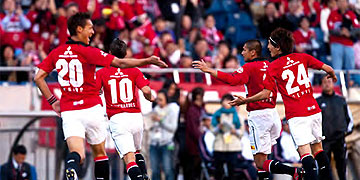 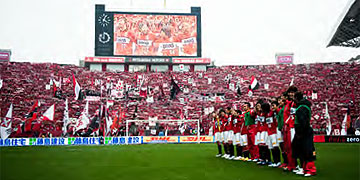
|
|
| 2013 #Chasing Three Titles | ||
| Returning to the AFC Champions League after a gap of five seasons, Reds acquired national team quality players in defenders Daisuke Nasu from Kashiwa Reysol and Ryota Moriwaki from Sanfrecce Hiroshima, midfielder Kunimitsu Sekiguchi from Vegalta Sendai and striker Shinzo Koroki from Kashima Antlers. Reds handed eventual Champions League winners Guangzhou Evergrande of China their only defeat of the tournament, 3-2 at Saitama Stadium, to finish the group on 10 points but a draw and loss to South Korean club Jeonbuk Hyundai Motors weighed heavily and Reds missed out on advancing to the knock-out stage.Reds went all of the way to the final of the J. League Yamazaki Nabisco Cup, where they took the game fiercely to Kashiwa Reysol only to concede a goal themselves on Reysol's second shot of the match in first half additional time. Unable to hit back, Reds were runners-up again as they had been in 2011.Manager Petrovic's attacking style undoubtedly progressed in his second season in charge and striker Koroki's arrival, especially, gave a huge boost to their scoring power. Reds scored 66 goals in 34 league games, an increase of 40% from the 47 scored in the previous season. Though no Reds player ended near the top of the scoring rankings, the consolidation of Reds' playing style was proven by the fact that no fewer than 12 players found the net, led by Koroki on 13, midfielder Genki Haraguchi on 11, defender Daisuke Nasu on 9 and midfielder Yosuke Kashiwagi with 8 goals. Reds also conceded 56, however, a 33% increase from the 42 of the previous season. Reds held onto to second or third place for much of the season but dropped to sixth at the finish after losing theirlast three games. It was clear that they had let in too many. AFC Champions League : Qualifying group J. League : 6th/18 Yamazaki Nabisco Cup : Finalists Emperor's Cup : Third round |
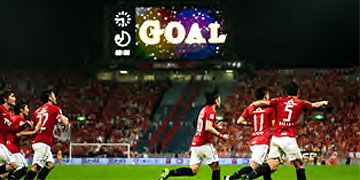 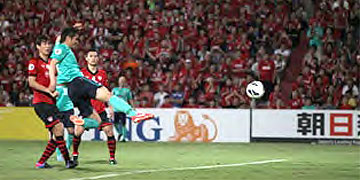
|
|
| 2014 #Disappointment in the Last Three Matches | ||
| For Misha's third season in charge, Reds strengthened the squad for their title challenge with thesigning of Japan keeper Shusaku Nishikawa from Sanfrecce Hiroshima,striker Tadanari Lee, hero of the 2011 AFC Asian Cup final, from English club Southampton, and midfielder Takuya Aoki from Omiya Ardija. The club was rocked early in the season by having to play the first ever J.League match behind closed doors but the players quickly resolved to reunite the club and supporters through their own power. Learning the lessons of the previous season, greater defensive awareness reduced the tally of goals conceded and Reds rose to the top of the table eleven matches into the season. Young star forward Genki Haraguchi was transferred to Hertha Berlin after the 14th Section but Reds regrouped and stayed top on the foundations of the playing combinations now practised for three seasons and also tremendous performances from 19-year old midfielder Takahiro Sekine, just inducted from the youth team this season.Striker Shinzo Koroki, who spearheaded the attack with his fine technique, was then injured in the 30th Section, however, and Reds struggled for goals at the finish. Reds could still have clinched the title in the 32nd Section at home to Gamba Osaka in front of 56,758 fans, the J.League's largest crowd of the season, at Saitama Stadium. Reds controlled much of that game with sparkling attacking play but could not translate their chances into goals and then lost after conceding a goal in the 88th minute when Gamba counterattacked from a free kick in their own half. Reds led 1-0 in the next match at Tosu until conceding at a corner in the 4th minute of additional time. That 1-1 dropped Reds into second place. Reds secured their berth at the 2015 AFC Champions League but, after having led the J.League table for 20 matches of the 34 game season, were bitterly disappointed to see the championship slip from their grasp at the last. J.League: 2nd/18 Yamazaki Nabisco Cup: Quarter finals Emperor's Cup: Third Round |
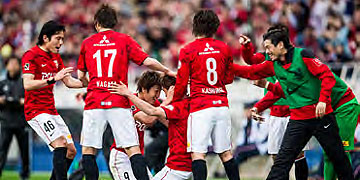 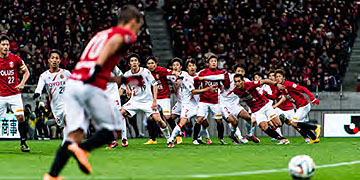 |
|
| 2015 #A Fine Start not Sustained | ||
| Reds brought in six reinforcements, including Slovenia national team striker Zlatan LJUBIJANKIC, and started the season with the declaration they were going to win titles this year. Reds finished bottom of their Asian Champions League group with only one win but then moved into gear in mid-April. The J. League reverted to a two-stage system in 2015. Reds had learned the lessons of the previous season and focussed well at the back, and splendid play by Takahiro Sekine, in his second season at the club, and Yuki Muto, newly signed from Vegalta Sendai, added fresh vigour up front. The victories piled up and Reds swept the First Stage undefeated with 12 wins and 5 draws in 17 matches. The pace dropped off in the Second Stage but Reds nonetheless advanced to the championship play-offs in second place in the overall table only to lose 3-1 in extra-time to Gamba Osaka in the semi-final. Reds lost again to Gamba, 2-1, in the Emperor’s Cup Final at the end of the season to finish the season empty-handed again. |
 |
|
| 2016 #Another Cruel Experience in the Championship Play-offs | ||
| Reds signed a number of promising young players, including defender Wataru Endo from Shonan Bellmare and midfielder Yoshiaki Komai from Kyoto Sanga. Misha (Mihailo Petrovic) declared that Reds would chase every title and achieve better results than last season. As promised, the team connected even better this season on the field. Reds showed they had what it took to compete in the Asian Champions League by drawing 2-2 away and winning 1-0 at home against the defending champions, Guangzhou Evergrande (China), before falling unluckily on penalties to FC Seoul(South Korea) in the Round of 16. The KLM Trio of Shinzo Koroki, Tadanari Lee and Yuki Muto notched up the goals in the J. League, leading Reds to third place in the First Stage. Reds then raced away with the Second Stage, including big wins against such clubs as Sanfrecce Hiroshima(3-0) and Gamba Osaka (4-0), and equalled the all-time record of 74 points in a season in the overall table, two points ahead of Kawasaki Frontale. In the meantime, Reds also won the re-named Levain Cup (formerly the Yamazaki-Nabisco Cup) 5-4 on penalties after drawing 1-1 with Gamba Osaka in the final. Reds’ opponents in the championship final were Kashima Antlers, who finished third on 59 points but overcame Frontale in the semi-final. A penalty by captain Yuki Abe secured a 1-0 advantage from the away leg and Shinzo Koroki extended that by scoring first in the home leg as well. Antlers equalised before half-time, however, and reversed the score on the night with a 79th minute penalty to level at 2-2 on aggregate and take the title on away goals. AFC Champions League: Round of 16 J. League First Stage: 3rd/18 J. League Second Stage: 1st/18 Overall: 2nd/18 YBC Levain Cup: Winners Emperor’s Cup: Fourth round |
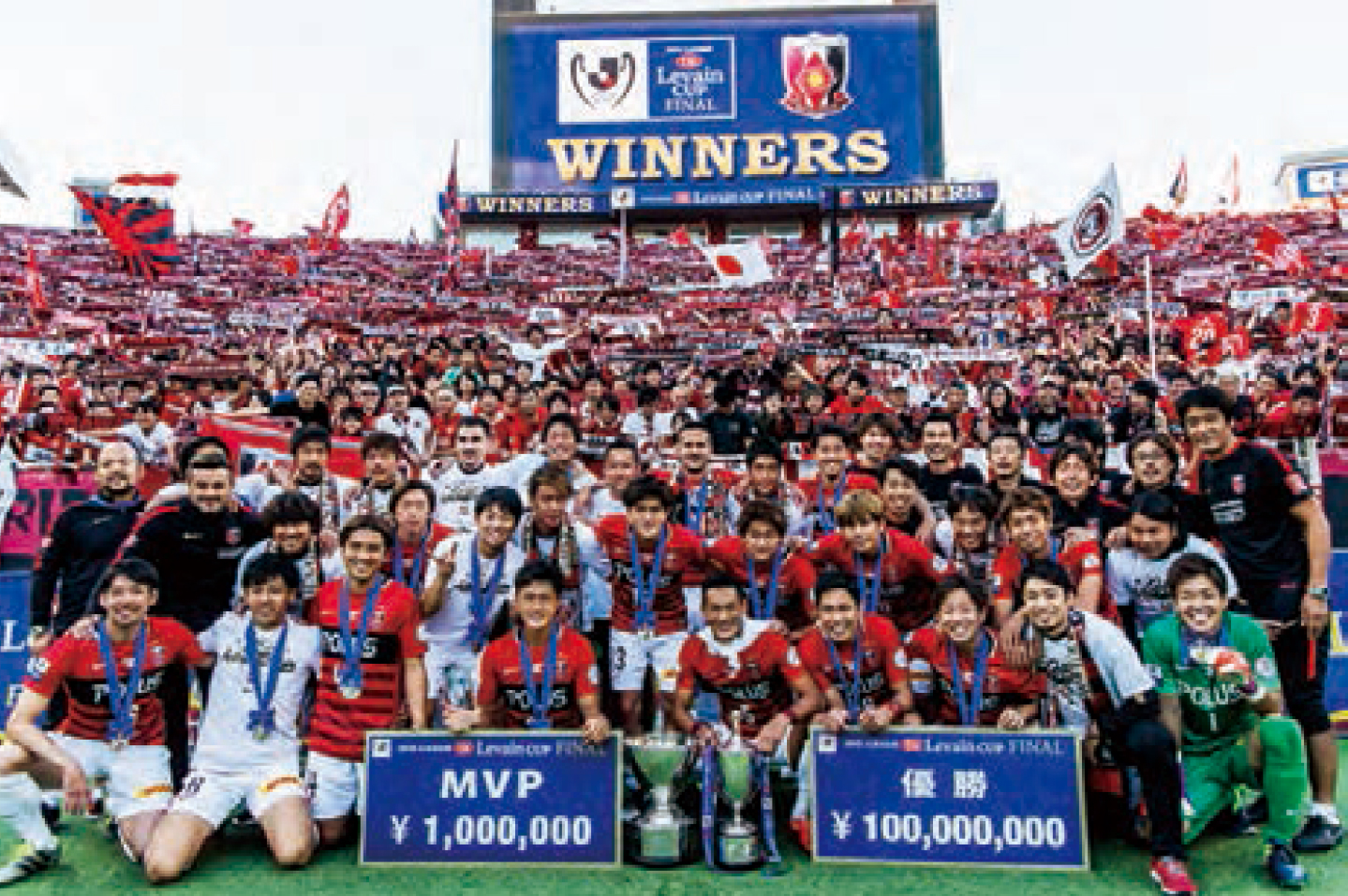 |
|
| 2017 #Second ACL Triumph | ||
|
Reds signed forward Rafael Silva from Albirex Niigata and the attack was on fire with 18 goals in 6 games in the group stage of their third consecutive AFC Champions League and sixth overall. Reds lost the away leg of the Round of 16 2-0 to Jeju of South Korea but fought back to a 3-0 win at home to advance to the last eight for the first time in 9 years. This was Misha's 6th year in charge and the team's mature combination and Rafael Silva's superb shooting prowess initially lifted Reds to the top of the J. League table. The exhaustion began to show, however, after those gruelling games against Jeju. The defence leaked goals, the losses piled up, and Reds slid down the rankings. With no recovery in sight, Misha was released at the end of July and head coach Takafumi Hori took over. Soon after, Reds won the Suruga Bank Championship 1-0 against Chapecoense of Brazil and then, in September, Hori switched from Misha's established 3-4-2-1 playing formation to 4-1-4-1. Brazilian defensive signing Mauricio from Portuguese club Maritimo had an impact, too, in restoring stability at the back. Reds staged a mighty recovery against fellow Japanese club Kawasaki Frontale in the ACL quarter-final, losing the first leg 3-1 away and conceding the first goal in the home leg, too, before winning the tie with four straight goals. Reds then drew 1-1 away and won 1-0 at home in both the semi-final and final, against Shanghai SIPG (China) and Al-Hilal (Saudi Arabia), respectively, to secure their second Asian title after a gap of 10 years. Reds wound up 7th in the J. League and finished 5th at the FIFA Club World Cup in the UAE after defeating Casablanca of Morocco 3-2. AFC Champions League: Winners FIFA Club World Cup: Fifth place J. League: 7th/18 YBC Levain Cup: Quarter finals Emperor’s Cup: Round of 16 FUJI XEROX SUPER CUP: Runners-Up Suruga Bank Championship: Winners |
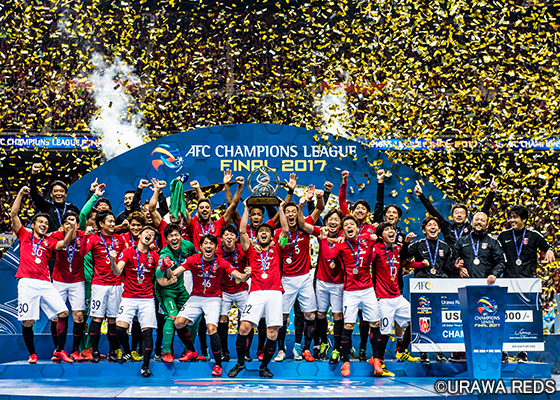 |
|
| 2018 #A Year of Ever Closer Ties with the Supporters | ||
|
Reds made a slow start to the season. Takafumi Hori was released and academy director Tsuyoshi Otsuki took over as caretaker for 6 games until Brazilian manager Oswaldo Oliveira's appointment on April 25th. The J. League broke off from May through July for the FIFA World Cup and Oliveira used the time to build up the players' physical strength, especially. With the arrival also of Brazilian forward Fabricio from Portuguese club Portimonense, Reds rose rapidly up the table. Fabricio, though, was eventually sidelined by injury and Reds failed to achieve their target of a top-three position. Instead, Oliveira’s new-look attack shone from the restart in the Emperor’s Cup and Reds continued all of the way in that competition by overcoming Kashima Antlers in the semi-final and Vegalta Sendai 1-0 in the final to lift the trophy for the first time in 12 years. Oliveira invited supporters to watch the players train on the day before both matches to achieve the perfect fusion between players and fans. J.League:5th/18 YBC Levain Cup:Play-Off Stage Emperor’s Cup:Winners |
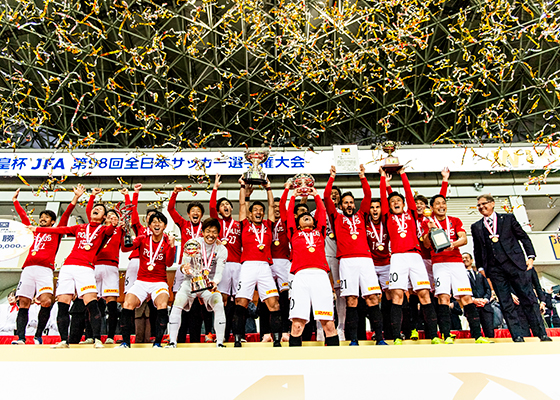 |
|
| 2019 | ||
|
AFC Champions League: Runners-Up J.League:14th/18 YBC Levain Cup:Quarter finals FUJI XEROX SUPER CUP: Runners-Up Emperor’s Cup:Round of 16 |
||
| 2020 | ||
|
J.League:10th/18 YBC Levain Cup:Qualifying group |
||
| 2021 | ||
|
J.League:6th/20 YBC Levain Cup:Semi finals Emperor’s Cup:Winners |
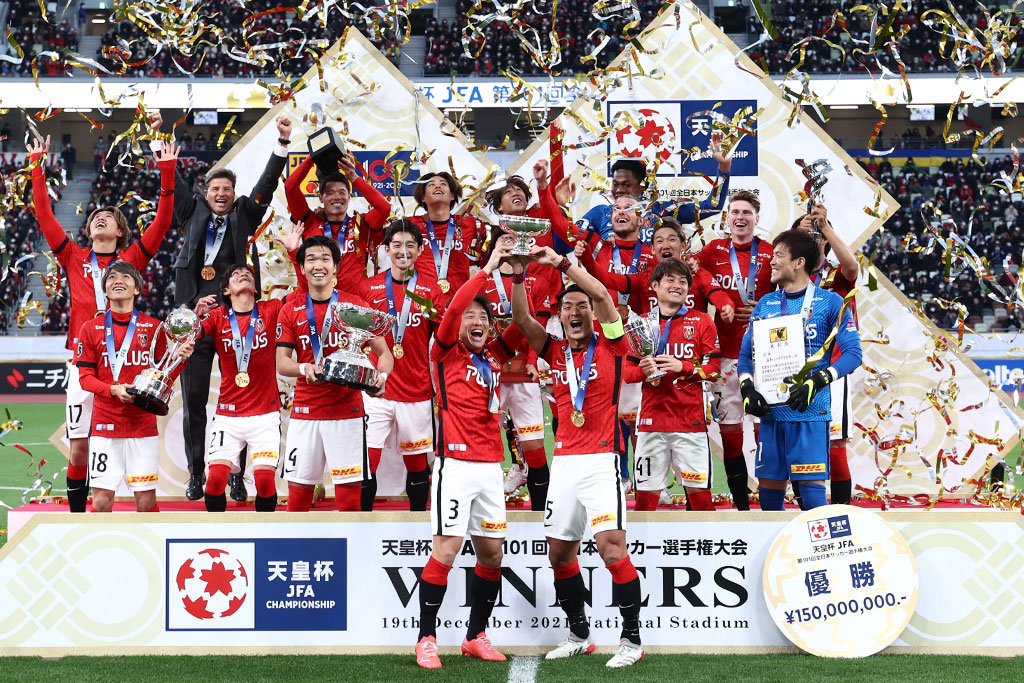 |
|
| 2022 | ||
|
AFC Champions League: Advance to the final J.League:9th/18 YBC Levain Cup:Semi finals FUJIFILM SUPER CUP: Winners Emperor’s Cup:Third Round |
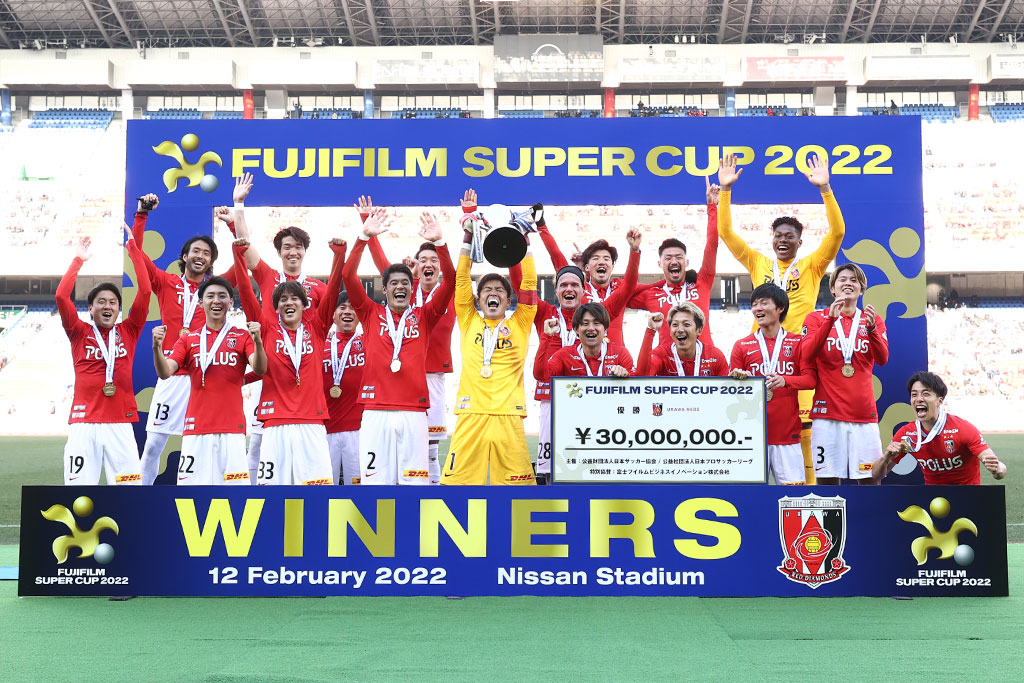 |
|
Copyright 1996-2009 URAWA RED DIAMONDS All rights reserved.